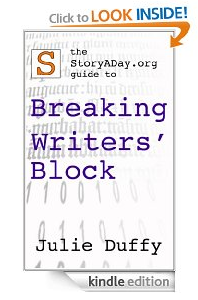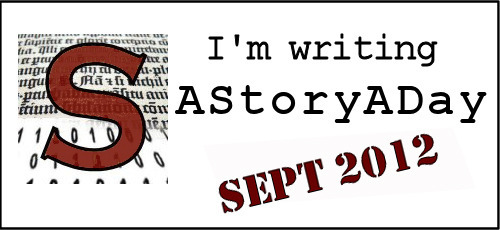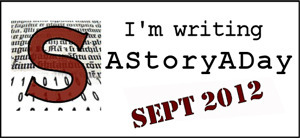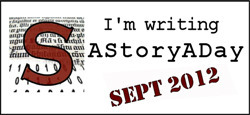Julie Duffy's Blog, page 191
August 31, 2012
A Challenge — And A Gift
StoryADay September ’12 starts TOMORROW!
But more about in a minute.
First: I have a gift for you, and a favor to ask.
The Gift: Your Tools For Breaking Writers’ Block
 This will be my fourth StoryADay challenge. I’ve had to get pretty good at side-stepping writers’ block.
This will be my fourth StoryADay challenge. I’ve had to get pretty good at side-stepping writers’ block.
Now you can have 60+ of my best techniques for breaking through resistance, in handy ebook form, free until Sunday Sept 2, 2012
The StoryADay.org Guide To Breaking Writers’ Block
You can get your copy FREE until Sunday, Sept 2 just by clicking ‘buy’.
What’s Inside?
The tips are arranged by section:
Creativity Exercises
Physical Comfort
Goal-Setting
Accountability and Rewards
Examining The Problem
Boot Camp (Just Do It!)
Prove It To Yourself
Seeking Inspiration
You can read the book through once or dip in and out whenever you need a boost.
Why Free?
Honestly, it’s a blatant attempt to rise higher in the Amazon rankings and improve the visibility of my book. Every copy downloaded by you (or someone you tell about it) in the next few days, boosts its sales rankings and helps future, paying readers find it. This, in turn, helps me pay for StoryADay.org and keep it free to you. Oh, and it’s DRM-free, so you should be able to share it between devices freely.
Why Kindle?
Ebooks are easy and Amazon makes it particularly easy to get your book into the distribution stream. They offer 70% royalties, which was unheard of in the publishing world before they came along. And I love my Kindle.
Also, I’m researching the whole process and writing it up, and will release a report on it a few months from now. You’ll be able to use this report to figure out whether or not it’s worth your time to put together your own ebook (a collection of short stories perhaps?) and how to avoid making mistakes along the way. This report will be free to members of the StoryADay.org Advance Notice List.
What You Can Do
You are welcome to download the book and do nothing more. But I would really, really appreciate it if you would consider doing some of the following steps. It really helps.
“Buy” the book during the free promotion period (before Sept 2)
Share the link with writer friends and tell them to buy it while it’s free.
Repost the link at Facebook, Twitter, your blog, whatever other social media you use,
Leave a review at Amazon. 20 words is all it takes and it makes a huge difference tot he book’s visibility.
Read the book and get excited about your writing
Get Your Free Copy of the StoryADay.org Guide To Breaking Writers’ Block NOW
StoryADay September Is Almost Here!
Tomorrow. Can that be right? Tomorrow?!
OK, deep breath.
If you’re NOT doing the StoryADay Sept’12 challenge, no need to unsubscribe. This list will not be flooded with daily prompts or chatter about the challenge. You’ll have to get on the Daily Prompt email list or go into the community for all that stuff. You’ll just get a nice, helpful writing-related post now and then, and news about upcoming challenges.
But, even if you’re too busy with other projects, why not goad your writing friends and challenge them to take part? It’s not too late! 
If you ARE doing the September Challenge here are a few things you might want to be checking:
Have you subscribed to the Daily Prompt email? You don’t have to, and you certainly don’t have to write to them, but some people find it useful. If you don’t want a nagging, I mean “inspiring”, email in your inbox every morning, you can still find the prompts on the blog every day if you ever need them.
Have you joined the community? It’s a great place to check in and post your Victory Dance every day, or get encouragement from others when you are lagging.
Have you added your name to the blogroll? There’s nothing like a little publicity to keep you honest!
Are you collecting story sparks? Keep collecting them every day during the challenge and you’ll always have something to write about.
Have you downloaded your free copy of the StoryADay.org Guide to Breaking Writers’ Block? You might need it in ten days or so…
And that’s it from me, except to wish you luck, persistence and courage.
See you in the forums?
Keep writing,
Julie




August 30, 2012
Paper or Plastic? How do you write?
I’m often asked how I write—how, physically, do I write? Pen and paper? Computer? Portable device? Onto my blog?
This is a question you, too, should consider for yourself before you set yourself any kind of writing challenge (like, for example, writing a story a day for a month!)
How will you:
* Write whenever and wherever you get the chance?
* Keep track of everything you’ve written?
* Find a way to work that is comfortable for you?
So should you commit to writing in a notebook? ON a netbook? At your trusty (or flaky) computer?
Honestly, the answer for you (as it is for me) is probably a mixture of all of them. So here are my tips and tricks for:
* Using all the writing technology at your disposal for maximum productivity (without losing your mind)
* Keeping and retrieving your masterpieces for later editing.
Paper and Pen(cil)
The pros and cons to this are pretty straightforward.
Pro:
* You can get a paper and writing implement pretty much anywhere.
You don’t need batteries, a network.
* Nothing pops up on your page to distract you.
* Editing as you write is difficult. You’re pretty much limited to crossing things out and writing in the margins. Getting to the end of a first draft before editing, should be easier than on a computer.
* You can do it pretty much anywhere (except, perhaps, in the dark.)
* Handwriting fires up areas of your brain [LINK] that are associated with deep understanding and memory. It is a very different experience from typing.
Cons:
* You need to have a paper and pen(cil) handy. What if you can’t find your favorite pen? Will you spend so long looking for it that you don’t write?
* Editing after the story is finished is going to require you (probably) to transcribe the story into a computer or write it all out longhand again. Not necessarily a con though, as that can help with the editing process. Definitely a con if your time is severely limited.
* Scraps of paper are easy to lose and hard to find once they’re lost. This is less the case with computer files.
Tips for Working With Pencil And Paper
* Set up a system now for retrieving your work later. Some options include:
** only using one notebook (or series of notebooks) for each project.
** Designate a StoryADay notebook and carry it everywhere. Only use that blue-covered copybook from Staples that you like, for your novel.
** Using looseleaf paper can be helpful if you write in different places or like to edit on paper. You can get hold of binder-sized paper pretty much anywhere. When you get home, file your stories in one binder, and you should be able to keep track of things. This requires some discipline in promising you’ll always file the stories away but it’ll be worth it three months from now when you try to find them again!
* Find paper that is a joy to write on, if you’re that way inclined. Have a cramped notebook with lines that are too dark or too light or too far apart, and a spine that doesn’t crack open far enough, or pages that are so small that you have to turn them every couple of sentences? This is just one more way to make it easy to skip today’s writing. Make writing a physical pleasure as well as a mental one, by treating yourself to some paper that you love and will want to spend time everyday caressing.
Desktop Computer
Again, the pros and cons are fairly straightforward:
Pros
* You know where it is and how to use it (you do, don’t you?)
* You probably have a decent word processor built right in and, chances are you are very comfortable typing at a decent speed.
* Even if you can’t remember how you decided to organize your file folders last week, you can easily search your computer for errant stories.
* You can easily edit and save multiple versions.
Cons
* It is all to easy to get distracted by the Internet
* It is very easy to edit, leading to you fussing with bits you have already written and never moving forwards.
* It is tempting to play around with formatting when you’ve got a nice powerful word processor that you can use to show you exactly how your story will look when set in the format used by Glimmer Train or The New Yorker (not that I’ve ever…oh shut up!).
Tips for using a computer
* Designate a folder for all your fiction writing, another for non-fiction, another for semi-thought-out blog posts. File your work.
* Save often. Seriously I cannot stress this enough. And still you’re going to need to experience the pain of losing a masterpiece before you put this into practice. But Save OFTEN. Train your fingers to mash the ‘ctrl’ and ‘s’ buttons together every paragraph or two. You’ll be glad you did.
* Use the simplest program you can. I use IAWriter when composing (I’m using it now). Use the full-screen mode in your word processor-of-choice.
* Turn off the Internet (Unplug the LAN cable, turn the sound down, turn off wi-fi, whatever you have to do). Do nothing but write when you are writing. No checking email, Facebook or Twitter. Ever.
* Name your files sensibly. You can call them all “StADASept12 The One About The Woman And Her Garden”, “StADaSept12 The Dog In The Ditch” if you think that’s likely to help you remember which is which, and where you put them. If you are writing a series of stories about the same characters always name the file with the same character’s name “Sarah stories – fishing in the creek with Grandma” “Sarah stories – Going to the corner shop”
Using A Laptop/Netbook/iPad/Tablet
If you move around a lot and are comfortable with a mobile device (and don’t want to hand write) it probably makes a lot of sense for you to use one of these devices.
Pros
* They are with you all the time or easy to move to wherever you are.
* You don’t need good lighting.
* Spellcheck.
Cons
* Battery life.
* If they are connected to the Internet you risk getting distracted.
* Comfort. Smaller keyboards and screens can make for a frustrating experience. Though I find them great for writing, less so for editing.
* Version control. If you’re using a mobile device and a desktop you run the risk of having (and working on) different versions of your story at the same time.
Tips for Using Mobile Devices
* Decide on how you are going to handle version control. If you work both on an mobile device and a desktop, consider saving all your work to Dropbox, Google Drive, iCloud or some other remote location (not your computer’s hard drive). This way, you’ll open the same file on either machine. By all means periodically copy all the files to an archive folder on your machine but call it something like ‘archive’ so you don’t get confused about which file is the latest version.
* Pick programs that play well together. I tried using Scrivener on my desktop and iaWriter on my iPad and ended up spending a ridiculous amount of time trying to learn/figure out how to sync the two. (My fault, not theirs, but not something I was willing to spend the time to learn properly during a challenge!). If you have Word or Pages or Scrivener or a simple text program on both your machines, use it. You can always export them to something else when it’s time to edit and submit.
* Get a bluetooth keyboard for your tablet. Yeah, yeah, they have onscreen keyboards and hand-writing recognition and speech-recognition, but a neat little keyboard still trumps all that for most of us.
* If it works for you, consider downloading something like Dragon Dictate which will transcribe your stories. (Way back, the desktop version of this was quite good because I could train it to understand my Scottish-American mongrel accent. The iPhone app version doesn’t seem as versatile, so this doesn’t work for me).
On A Blog
Some people post their stories every day to a blog. They may even write them write in the blog-software window. There are some fairly big (and non-obvious) pros and cons for this one.
Pros
* You get to share your work immediately – especially good if you have a writers’ group or a bunch of dedicated readers.
* You can easily find your stories again. Even if your hard drive dies.
* There is a off-the-cuff, relatively uncrafted esthetic to blogging that might help you write with abandon every day.
Cons
* Publishing your work on a blog may cause some editors to consider the work ‘previously published’ and render it invalid for inclusion in magazines and competitions.
* Writing in the blog window leaves you at the mercy of your internet connection and the host’s servers. One blip and your whole story can be lost otherwise.
Tips For Writing On Your Blog
* Consider writing offline and then pasting the content directly into the blog window. Write in a plain text program and then pretty it up once you’re in the blog window.
* Save drafts obsessively as you work on them.
* Use your blog software to set up categories and tags for your stories. That way it’ll be really easy to find all the stories you wrote during StADa Sept ’12, or all the stories your wrote that were autobiographical, or all the fairy stories…
* Consider password-protecting or marking as ‘private’ any entries you think you might rework for submission to magazines or contests. If no-one else can see them, no-one can consider them ‘published’.
So how do YOU write? Have any tips for keeping your writing flowing?




August 28, 2012
[Write on Wednesday] – Mnemosyne Remembered
Hollywood is all about the ‘reboot’ these days: taking familiar characters from fairy tales and comics and even TV series, and telling their stories again, in a new way.
It seemed only appropriate to ask you to write a story that features Mnemosyne, Greek titan, mother of the nine muses, and the figure responsible for the telling of all the tales (and committing them to memory) before writing was invented.
“Of the female Titanes they say that Mnemosyne discovered the uses of the power of reason, and that she gave a designation to every object about us by means of the names which we use to express whatever we would and to hold conversation one with another; though there are those who attribute these discoveries to Hermes. And to this goddess is also attributed the power to call things to memory and to remembrance (mneme) which men possess, and it is this power which gave her the name she received.”
-Diodorus Siculus, Library of History 5. 67. 3 (trans. Oldfather) (Greek historian C1st B.C.) source
The story also goes that Mnemosyne was the daughter of Gaia (Earth) and Ouranos (Sky). It also says that Zeus spent nine consecutive nights with her and nine months later the nine muses were born. Later still, she watched over a pool in the underworld that was named for her. When people arrived in the underworld they would first drink from the waters of the Lethe (Forgetfulness) to forget all that had come before and then drink from the waters of Mnemosyne (Memory) so that he could remember what was to come.
The Prompt
Write a story in which one of your character shares some traits or life experiences with Mnemosyne.
Tips
Perhaps she IS Mnemosyne in a modern, futuristic or fantasy setting
Perhaps she only has one of Mnemosyne’s gifts: maybe she works for companies as a ‘namer’ of new products. What power does that give her? What does it cost her?
Perhaps she has a fast and furious romance with epic consequences.
Perhaps your Mnemosyne works as an counsellor for new immigrants to Mars, or elderly people, newly-arrived at a nursing home.
Optional Extras:
Share this challenge on Twitter or Facebook
Some tweets/updates you might use:
Don’t miss my short story: Mnemosyne, Remembered #WriteOnWed #storyaday http://wp.me/p1PnSG-Dc
This week’s #WriteOnWed short story prompt is all about the mother of the muses #storyaday http://wp.me/p1PnSG-Dc
Come and write with us! #WriteOnWed #storyaday http://wp.me/p1PnSG-Dc
See my story – and write your own, today: Mnemosyne Remembered #WriteOnWed #storyaday http://wp.me/p1PnSG-Dc




August 15, 2012
How To Set Your Writing Rules
 The StoryADay Rules say there is one rule, “Write and finish a story every day. That’s it.”
The StoryADay Rules say there is one rule, “Write and finish a story every day. That’s it.”
They then promptly go on to talk about all the ways you can add to — or subtract from — that absolute.
I know it’s a bit confusing. It’s my fault. I appreciate rules, but I’m just not very good at being told what to do and I fail to see why I should expect other writers to be any better. Hence…
So, here follows my attempt to make sense of the part where the site says “set your own rules.”
What Do You Mean “Set Your Own Rules”?
The point of doing this challenge is to push yourself to do more than you thought you possibly could.
The point is to unleash the flood of creativity that comes when you have to write every day.
The point is not to give you yet another way to fail at a creative endeavor.
So yes, you should set yourself a goal that seems momentous, preposterous, monstrous even. And maybe for you that will be: writing 30 stories in 30 days. But maybe it will mean writing a story on five out of seven days. Or limiting yourself to 100 word stories. Or taking Thursday’s off.
If you know that your Saturdays are packed with people and obligations, sun-up to sun-down; or if you have tried the challenge before and noticed that you always failed to finish a story after five days of successes; or if you are a member of a religious group that takes the holy day extremely seriously, don’t torture yourself. Write it into your rules that you get to take certain days off.
How Do I Know What A Good Set Of Rules Is, For Me?
And if you haven’t done the challenge before (or if you haven’t written anything for a while) I strongly encourage you to stick to the basic rule: write and finish one story every single day for a month.
I know that sounds ridiculous in itself: surely if you haven’t been writing you should warm up a bit, ease yourself in? No. Sorry. This is not like running a marathon. You’re not going to pull a muscle or ruin your knees.
If you haven’t pushed your short-story writing before, you have no way of knowing what your boundaries are. Only by trying to write a complete story every day for 30 days can you know whether or not you can do it. Or how close you can come. And the effort is its own reward.
If, however, you took part in May, you’ll have a good sense of how much time you could make for writing, and what your goals need to be.
Just be honest with yourself. If you wrote 12 stories in May you might be secretly disappointed in yourself — or you might be thrilled. It all depends on you, and your circumstances. Just set yourself a goal that’s a little more ambitious than whatever you accomplished before and promise yourself you will push and push to get to it.
The Second Rule
The second absolute rule you should set yourself is to treat every day as a new day until the end of the month.
No going back to finish yesterday’s story – until next month
No berating yourself for yesterday’s shortcomings
No looking ahead and saying “I’ll never make it!”
Try your utmost to stick to your writing rules today. Forgive the past, and forget the future. Just write today.
What If I Fail?
Well, first of all, I have a problem with that word: “fail”.
Did you try? Then you didn’t fail. Did you complete a story every day for a month? No? Hmm, well, did you learn something about your style or your voice or your writing method? Did you write more than you wrote the month before (or in any month before. Ever.)?
There may well be days when you fail to finish a story. Forget it. Forgive yourself and move on. You are in pursuit of a great challenge here. Keep after it.
It’s entirely likely that some of your stories are great steaming heaps of passive voiced, prepositionally phrased, tedious prose peopled by heroes who wouldn’t know a plot point if it pointed right at them. Don’t give up on them. Keep writing until you get to the end. Even if you have to kill someone (in fact, that can be kind of fun). Pushing through to the end of a story teaches you so much more than giving up and starting afresh. Finish.
And if it gets to midnight (or whenever you go to bed) and you simply cannot finish today’s story: get some rest. Let it go and vow to start afresh tomorrow.
When the month is over, you can revise what’s worth saving, and learn from what’s not. While the challenge is still running, just keep writing. Strike the word ‘fail’ from your vocabulary. So long as you are writing, you cannot fail. Pat yourself on the back. You wrote. You got complete stories out of your brain — where you didn’t even know they were lurking — and on the page. You are courageous and to be congratulated.
Can I Adjust My Rules?
Yes. Absolutely. This is your challenge. I’d rather you adjusted your rules than gave up. Just don’t be too easy on yourself. This is meant to be a, er, challenge!
In Conclusion
Set ambitious goals
Try to meet them. At the very least, put some kind of ending on each story.
Be hard on yourself every morning and kind to yourself at the end of every day.
Treat every day as a new challenge (don’t look back!)




August 14, 2012
[Write On Wednesday] Subtle Signs
Over at Wikipedia, today’s Picture of the Day is At Breakfast by the Danish artist L. A. Ring.
Apart from being quite beautiful, the picture is a study in subtlety. According to the accompanying text, the artist is supposed to have surrounded his model (his wife) with subtle signs of his affection for her.
The Prompt
Write a story in which the objects surrounding your characters reflect how they feel about each other.
Tips
Your characters don’t have to love each other. They might be enemies with jagged, broken window in the background of your scene.
Don’t overload your story with details like this, but pay attention to the surroundings and include one or two clues.
Or, alternatively, you can go crazy with this. Be silly. It’s just an exercise!
The Rules:
1. You should use the prompt in your story (however obliquely you use the ‘want’, it should be there in the character and all their reactions).
2. You must write the story in one 24 hr period – the faster the better.
3. Post the story in the comments — if you’re brave enough.
4. Find something nice to say about someone else’s story and leave a comment. Everybody needs a little support!
Optional Extras:
Share this challenge on Twitter or Facebook
Some tweets/updates you might use:
Don’t miss my short story: Subtle Signs #WriteOnWed #storyaday http://wp.me/p1PnSG-CW
This week’s #WriteOnWed short story prompt is all about subtle signs in the background #storyaday http://wp.me/p1PnSG-CW
Come and write with us! #WriteOnWed #storyaday http://wp.me/p1PnSG-CW
See my story – and write your own, today: Subtle Signs #WriteOnWed #storyaday http://wp.me/p1PnSG-CW




[Reading Room] The Fog Horn by Ray Bradbury
I came a little late to the stories of Ray Bradbury and that’s probably a good thing. I was much too literal as a teenager and probably wouldn’t have known what to make of his fantastic, thought-provoking, stories with their lyrical language.
When I did discover his writing, of course, I had my mind blown in little controlled explosions by stories like “A Sound of Thunder”, “The Rocket Man” and “The Fog Horn”.
But I hadn’t read any of his stories for years. Now, getting ready to introduce them to my own children, I picked up a collection of his early stories and sat down to read.
The very first story in the collection was “The Fog Horn”, one of my very favorites.
As I started to read, I was a little worried that I had over-romanticized Bradbury’s stories in my memory. Here were two lighthouse-keepers oiling the lamp and chatting in a fairly mundane way about their job. Maybe I wasn’t going to be as transported, at this age, as I was a decade or more ago.
Then the older lighthouse keeper tells the younger a theory he has about how the fog horn was invented.
“One day many years ago a man walked along and stood in the sound of the ocean on a cold sunless shore and said, ‘We need a voice to call across the water, to warn ships. I’ll make a voice like all of time and all of the fog that ever was. I’ll make a voice that is like an empty bed beside you all night long, and like an empty house when you open the door, and like trees in autumn with no leaves. A sound like the birds flying south, crying, and a sound like November wind and the sea on the hard, cold shore. I’ll make a sound that’s so alone that no one can miss it, that whoever hears it will weep in their souls, and hearths will seem warmer, an being inside will seem better to all who hear it in the distant towns. I’ll made me a sound and an apparatus and they’ll call it a Fog Horn and whoever hears it will know the sadness of eternity and the briefness of life.’”
The Fog Horn blew.
And that’s just for starters.
The ideas in Bradbury’s stories are wonderful and the worlds are fantastic or sometimes mundane and all of the experiences are deep and human, and the language..ah the language.
You might not love his stories the way I do, but I would recommend reading a few of them if only to see in practice this truth: you should not be afraid to write in your own voice.
Bradbury is often referred to as a science fiction writer because his most famous stories deal with rockets, and Mars and time-travel. Bradbury was writing during the ‘Golden Age’ of speculative fiction and that’s where his stories were being published – in Sci-fi magazines. But he doesn’t try to sound like his peers, nor does he limit himself to descriptions of the cold depths of space, spaceships or alien planets. He writes in an inimitable, poetic style about ideas that fascinate him in words that could only come together in that order, out of his Bradbury brain.
Go you, and do likewise.




August 8, 2012
Announcing StoryADay September 2012
For the past three years we’ve been getting together in May to write A Story A Day. It has been some of the most creative, inspiring, productive writing time I’ve ever had and I’m not alone:
“I love this challenge…” – Marta
“ I reached most of my goals and learned more about my writing habits.” - Chit
“I have discovered that I do believe in myself as a writer – as cliched as it seems, writing regularly really does make you a writer. So, here’s to discovery…without which I would still be stumbling alone in the dark rather than enjoying the sunshine with my muse.” - Cat
So this year I asked around and discovered that you lot are crazy.
You want to write even more!
So, just for fun, let’s do it all again: in September

Are you finding it hard to find time to write?
Are you bogged down in the middle of a novel and need to refresh your sense of possibilities?
Are you a lover of short stories and the possibilities they offer?
Come and write with us this StoryADay September!
How It Works
The Rules are the same as ever:
Write (and finish) a story a day for a month. That’s it.
The Options:
Join the community and hang out with us,
Use the prompts (or not),
Set your own definition of what ‘a story a day’ means to you. (Need to take Saturday’s off? Hey, it’s your challenge, you make the rules. But once made, stick to them!)
Grab a badge for your website
The Victory Dance group in the community, or on that day’s blog post, to say you have written.
Share links to your story online if you want to. Don’t if you don’t.
What’s Different?
I’m not giving anyone the option to start a new StoryADay blog for the September challenge. It’s just a matter of administrative time. We’ll see how it goes. If you already have one, feel free to use it. Otherwise, post StADa-related news (and stories if you want) on your own blog and link to your posts in StoryADay’s blog comments and forum posts.
How To Sign Up
A, You don’t have, but it helps keep you honest. You can sign up at the site (see below) or just announce your participation to your friends.
B, If you want a username for the StoryADay.org community I’m opening up registration again now. A username gets you into the Community area where you can find friends and discuss writing with some other incredibly dedicated writers. It’s a wonderfully supportive community and I recommend signing up (it’s free and optional).
C, I’m going to post a ‘blogroll’ of participants on the front page of the site. If you’d like to be on it (optional) fill in this form. You can add your name to this list even if you don’t have or want a StoryADay username. If you plan to write, you’re in.
The More The Merrier
Remember, one of the reasons StoryADay works so well, is because you are part of something. Please, please tell your friends, blog about StoryADay Sept’12,
Tweet about it,
Mention it on Facebook,
Tell your real-world writers’ group.
The more people you enlist, the more likely you are to have an amazingly productive month. Trust me. I know

So tell your friends. Even if you can’t participate this time around, maybe you can be instigator and cheerleader for someone else!
Get Ahead Of The Game
If you’re intrigued, but unsure, there’s lots of great information in the FAQ and Resources pages at the site.
Also, I have a few downloads for you in the StoryADay Shop, from the free Creativity Challenge Workbook, to the Time To Write Workshop and the monster 3-week StoryADay Warm Up Writing Course – now available as in a Home Study Version for the first time – with an intensive, 10-day version included in case you’re in a hurry.
Check out the Shop for more information.
But most of all, start gathering your story ideas. Meet you back here on September 1!




August 7, 2012
[Reading Room] “Goodbye and Good Luck” by Grace Paley
I’ll tell you this up-front: I’m an optimist, a romantic. I like my heroes larger than life and my endings to, well, end. I get impatient with stories that are just like life: a little change here and there, but then they just stop and life goes on. I can appreciate stories like that. I can admire them. But I can never love them, or their protagonists.
The title of this Grace Paley story, “Goodbye and Good Luck” was an implicit promise from the author to the reader that this story would have a real change in it, that life wouldn’t just trickle on as before.
This was the first story I’m aware of having read that was written by Grace Paley, so I didn’t know if I could trust her to deliver on that promise, but she did.
Not only does the story have a beginning, a middle and a satisfying end, it has a real character as its protagonist — and I say that not in the literary sense, but in the way your grandmother would have said it: “Oh yeah, that Rosie. She’s a real character!”
Written in the first person though, the character doesn’t seem outsized. That, I thought, was an interesting lesson for writers. Just as your villain never sees himself not as the villain in someone else’s story but the hero of his own, truly remarkable characters don’t see themselves as remarkable. They are just as they are. Telling the story from their perspective is an interesting way of avoiding moralizing or lionizing or any other kind of -izing.
At the start of this story Rose begins to tell her niece Lillie, the story of her life. I was a little adrift at first, trying to figure out who was talking and where and when and why. I didn’t understand the rhythms of her speech or the minutiae of all the things she referred to. But as soon as I relaxed and let the story go, I realized it was useful. My unfamiliarity with the world of the story made it seem more realistically set in its own time and space. The author didn’t need to waste time explaining what “novelty wear” was. It was enough that the character, Rosie, knew. Perhaps even her niece didn’t know but Rose bulldozes on, telling her own story from the past, without stopping to check, and that told me plenty about Rose herself.
Rosie worked for a theater company in the grand era of Yiddish theater and is, herself, a grand storyteller. Soon you forget to wonder why Rose is telling this story to her niece. It pulls you along, capturing the rhythms and sounds, the mores and daily details of another time.
But of course there is a reason for the story. I sensed it coming and hoped I was right and then, there we were at the end of the story, like the end of a satisfying meal.
This story is a great example of how to use character and setting to tell a ‘simple’ story, in which there is little ‘on-screen action’, and how to include details without weighing the story down in acres of description and explanation.
Goodbye and Good Luck, indeed.




August 3, 2012
Let Me Bust Your Writing Excuses
The last two blog posts were all about what to do when you don’t feeeeeeel like writing (wah!)
This time I’m on a mission.
Post your biggest writing excuses below (‘not enough time’, ‘my inner editor won’t shut up’, ‘my ideas aren’t original’, ‘my kids are eating me alive!’) and I’ll let my inner drill sergeant loose on them.
Ready to have your go-to writing excuse busted? Post them now:




StoryADay Sept’12 Graphics
Here are your September 2012 Participant Badges!
Use them on your websites or where ever you like.
(Right-click to download whichever size you like)
500 x 230 pixels
300 x 138 pixels
250 x 115 pixels
200 x 92 pixels
150 x 59 pixels















